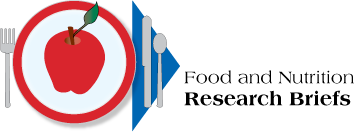| January 2005 |
Vitamin D Reduces Age-Related Falls
Elderly men and women who took vitamin D supplements fell down 22 percent less than those who didn't take supplements of this nutrient. That's according to a retrospective analysis of five major vitamin D studies encompassing some 1,200 seniors who were in stable health and were, on average, age 70. Vitamin D is thought to improve our muscles. Falls are the largest single cause of injury-related deaths among the elderly. An estimated one-third of people over age 65--and up to half of those over age 80--are injured in falls each year. ARS-funded scientists at the Jean Mayer USDA Human Nutrition Research Center on Aging at Tufts University, Boston, Mass., and their colleagues reported these findings in the Journal of the American Medical Association (volume 291, pages 1999-2006). For more information, contact Bess Dawson-Hughes, (617) 556-3064; ARS Jean Mayer USDA Human Nutrition Research Center on Aging at Tufts University, Boston, MA. Whole-Grain Rice Bread Mix Planned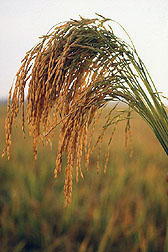
Whole-grain rice bread, warm and fragrant from your home bread making machine, may become a reality within the next year or so. That's thanks to a mix now being fine-tuned at the ARS Southern Regional Research Center, New Orleans, La. The experimental formulation yields a nutritious loaf with a pleasing texture that's much like that of conventional whole-wheat breads. The bread could offer a safe, healthful option for the approximately two million Americans who can’t eat breads made from wheat, rye or barley because of a condition known as celiac disease. Among them: members of the Louisiana Celiac Sprue Association who, in fact, have taste-tested the whole-grain rice bread and say it’s superior to some rice breads currently on the market. A 2001 article in the Journal of Food Science has background information (volume 66, pages 940-944). Researchers expect the mix to be commercially available in about a year. For more information, contact Ranjit Kadan, (504) 286-4332, ext. 332; USDA ARS Southern Regional Research Center, New Orleans, LA. Veggies Help Fight Stress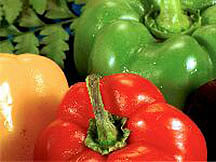
Stressed out? Eating vegetables on a regular basis for two weeks helped volunteers in a nutrition study reduce levels of stress-related molecules and boost their blood levels of vitamin C (Journal of Nutrition, volume 134, pages 3021-3025). Twelve healthy men and women participated in this collaborative study, which was funded in part by ARS. In addition to other foods, each volunteer ate two daily servings of gazpacho--a chilled soup made with tomatoes, cucumbers, green peppers, onions, garlic and olive oil. By the seventh day of the two-week-long study, volunteers' blood levels of vitamin C had increased by at least 20 percent and remained elevated for the rest of the study. Levels of four stress molecules decreased significantly. For instance, by the halfway point in the study, uric acid was reduced by 8 to 18 percent. High levels of uric acid can cause gout, a form of arthritis, and may increase risk of cardiovascular disease. For more information, contact Antonio P. Martin, (617) 556-3141; ARS Jean Mayer USDA Human Nutrition Research Center on Aging at Tufts University, Boston, MA. WIC Training: Free Course on Web
“WIC Learning Online,” a course designed especially for registered dietitians and others who work with clients of the WIC program, is available free of charge at: https://wicworks.fns.usda.gov/resources/wic-learning-online. WIC is short for USDA’s Special Supplemental Nutrition Program for Women, Infants, and Children. Specialists in the WIC Works Resource System of the National Agricultural Library, Beltsville, Md., developed the user-friendly course in collaboration with USDA’s Food and Nutrition Service and the University of Maryland, College Park. The library is part of the Agricultural Research Service. The course has tips on how to interview WIC clients, suggestions for presenting nutrition-education classes to WIC recipients, and related information about nutrition, food safety and top-quality customer service. The American Dietetic Association has approved the course for four continuing professional education credits for registered dietitians. For more information, contact Janice Schneider, (301) 504-6047; USDA National Agricultural Library, Beltsville, MD. New Kudos for Whole-Grain Foods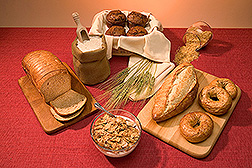
Eating at least three or more servings of whole-grain foods every day may lessen your chances of metabolic syndrome, a group of conditions that increase risk of Type 2 diabetes and heart disease. Metabolic syndrome comprises abdominal obesity, high blood pressure, poor blood-sugar control, low HDL cholesterol and high blood fats (triglycerides). Scientists at the ARS Jean Mayer USDA Human Nutrition Research Center on Aging at Tufts University, Boston, Mass., reported that finding (Diabetes Care, volume 27, pages 538-546) from their evaluation of food questionnaires and medical tests from 2,834 healthy men and women volunteers aged 26 to 82. Easy ways to get more whole-grain foods into your meals include choosing a whole- grain cereal at breakfast, whole-grain bread instead of white bread for your sandwich at lunch or brown rice instead of white at dinner. For more information, contact Nicola M. McKeown, (617) 556-3367; ARS Jean Mayer USDA Human Nutrition Research Center on Aging at Tufts University, Boston, MA. Cornering Campylobacter Genes, to Safen Foods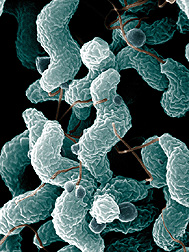
When you thoroughly cook chicken--whether roasting it to a golden brown or grilling it with your favorite barbecue sauce--you're also ensuring that the prolonged heat clobbers any Campylobacter jejuni bacteria. Raw chicken juice, or raw or undercooked chicken, can harbor this microbe and lead to campylobacteriosis food poisoning. Agricultural Research Service scientists in Albany, Calif., and their colleagues at The Institute for Genomic Research, Rockville, Md., have discovered more about this microbe. They decoded the sequence, or structure, of all of the genes in a specially selected C. jejuni strain, and most of the genes of three other Campylobacter species. Their preliminary analyses of these species appears in the online journal, PLoS Biology (volume 3, pages 72-85). The work may pave the way to faster, more reliable methods for detecting Campylobacter strains in samples from food, animals, humans and water. And it opens the door to simpler, less-expensive tactics for distinguishing look-alike species and strains so that culprit microbes in food-poisoning outbreaks can be fingered more quickly. This is the first time the genes of a C. jejuni strain from a farm animal--in this case, a market chicken--has been sequenced. That source is important, because chicken is thought to be the leading source of this bacterium in food--even though it is also present in pigs, cattle and sheep. For more information, contact Robert E. Mandrell, (510) 559-5829; USDA-ARS Western Regional Research Center, Albany, CA. Delicious, Low-Sugar Watermelons? Yes!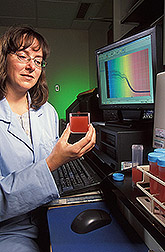
Can a low-sugar watermelon taste as crisp and refreshing as its conventional, higher-sugar counterparts? Yes, says an Agricultural Research Service plant geneticist who is developing delicious, red-fleshed watermelons with about 5 percent sugar content. Red watermelons we buy at supermarkets can have up to 14 percent. Though low in sugar, the fruit still provides lycopene, the scientists showed (HortScience, volume 39, page 654). This pigment gives the melon its attractive red color and is thought to help reduce risk of heart disease and certain cancers. The melon might be ready for seed producers within a few years. Using artificial sweetener will make the low-sugar watermelon taste fully sweet. That will be a boon for people who love watermelon but have to cut back on calories, sugar--or both. For more information, contact Angela R. Davis, (580) 889-7395, ext. 263; USDA-ARS South Central Agricultural Research Laboratory, Lane, OK. Colorful Carrots Boast Healthful Pigments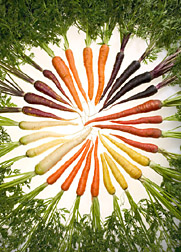
Carrots that come in an array of unconventional hues owe their coloration to natural pigments that have impressive health-promoting properties. ARS scientists at Madison, Wis., use conventional plant-breeding techniques to develop these and other specialty carrots. Attractive, yellow carrots from this research get their color from xanthophylls, which have been linked to good eye health. Red carrots contain lycopene, also found in tomatoes and thought to guard against heart disease and some cancers. Purple carrots’ anthocyanins are regarded as powerful antioxidants that help protect our cells from damage. Nutrition studies conducted in collaboration with the University of Wisconsin, Madison, showed that the yellow carrots' lutein was 65 percent as available to the body as it is from lutein supplements (American Journal of Clinical Nutrition, volume 80, pages 131-136). Lycopene from red-pigmented carrots is 40 percent as bioavailable as it is from tomato paste, giving people who don't like tomatoes another choice among food sources of lycopene. The findings might encourage growers to try out the novel carrots. USDA's Cooperative State Research, Education and Extension Service funded part of the research. For more information, contact Philipp W. Simon, (608) 262-1248; USDA-ARS Vegetable Crops Research Unit, Madison, WI. “Pistachio Blaster” Hears Perfect Nuts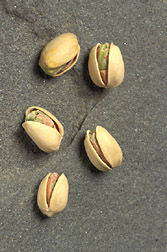
Perfectly ripened pistachios split open naturally so that the tasty, lime-green kernels look as if they are peeping out at you. A high-speed sorter called the "Pistachio Blaster” is helping ensure that only these premium, open-shell nuts make their way from orchards to you. At the pistachio-processing plant, the Blaster quickly sorts low-value, closed-shell pistachios from their premium, open-shell counterparts--with about 90 percent accuracy. Working at the respectable rate of about 25 nuts per second, The Pistachio Blaster analyzes sounds made during and immediately after each nut strikes a stainless steel block. The sound is picked up by a microphone, then sped to a computer that--when it detects the telltale bounce of a closed-shell nut--sends a signal that causes a blast of compressed air to direct the nut to the reject bin. Setton Pistachio of Terra Bella, Calif., holds a license for the patented Blaster. An article in a back issue of Applied Engineering in Agriculture (volume 16, pages 91-94) has details about the innovative sorter. For more information, contact Thomas C. Pearson, (785) 776-2729; USDA-ARS Grain Marketing and Production Research Center, Manhattan, KS. Dietary Guidelines: On the Web for You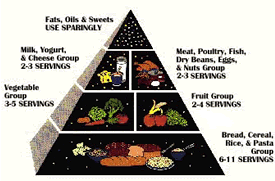
Expert nutrition advice on eating for your good health is offered in the new Dietary Guidelines for Americans 2005, now just a mouse-click away on the World Wide Web. Brief highlights, taken from the full report, are presented in a brochure, "Finding Your Way to a Healthier You: Based on the Dietary Guidelines for Americans " . An executive summary is designed for nutritionists, dietitians and other healthcare professionals. The full report is posted at www.dietaryguidelines.gov/about-dietary-guidelines/previous-editions/2005-dietary-guidelines-americans. The Guidelines provide practical, science-based recommendations about how to eat and exercise to prevent obesity and lower your risk of cancer, diabetes and other chronic diseases. The U.S. Department of Agriculture and U.S. Department of Health and Human Services update the Guidelines every five years. Fluoride Levels Documented in New, Online Database
Curious about fluoride? A new, online database from ARS' Beltsville (Md.) Human Nutrition Research Center indicates the amount of this nutrient in some 400 foods and beverages. The USDA National Fluoride Database of Selected Beverages and Foods-2004 should be particularly useful to nutrition researchers who are evaluating the question of how much fluoride we need for good health. Fluoride is added to many U.S. municipal water supplies--to help prevent tooth decay--and may end up in some water-based beverages and foods. The database resulted from an interagency agreement between ARS and the Bethesda, Md.-based National Institute of Dental and Craniofacial Research and the National Heart, Lung and Blood Institute, both part of the National Institutes of Health. The new compilation is based on scientific literature and analyses by scientists at the University of Iowa College of Dentistry, Iowa City. For more information, contact Rena Cutrufelli, (301) 504-0693; USDA-ARS Beltsville Human Nutrition Research Center, Beltsville, Md. Test Helps Keep Goat Milk, Cheese, Safe
Dairy-goat milk is high in protein, low in cholesterol, and is a nutritious option for people whose digestive systems react badly to cow's milk. Cheese made from goat milk is a flavorful addition to foods such as a fresh spinach salad. In the United States, about one million goats are raised for producing milk and cheese. Goat milk sold in this country may soon be analyzed with a test that detects antibodies made by goats in response to Brucella melitensis, the microbe that causes brucellosis. The test resulted from a collaboration between ARS, USDA's Animal and Plant Health Inspection Service and Iowa State University. It's an adaptation of an enzyme-linked immunoassay, or ELISA, from ARS for detecting another Brucella species. B. melitensis can induce abortions in animals, and can cause headache and fever in humans. Few cases of this infection in goats have occurred in the United States since 1972, but dairy-goat milk's gradual gain in popularity may lead to use of the new assay for testing goats, their milk, or both. For more information, contact Louisa B. Tabatabai, (515) 294-6284; USDA-ARS National Animal Disease Center, Ames, IA. |
|
The United States Department of Agriculture (USDA) prohibits discrimination in all its programs and activities on the basis of race, color, national origin, gender, religion, age, disability, political beliefs, sexual orientation, and marital or family status. (Not all prohibited bases apply to all programs.) Persons with disabilities who require alternative means for communication of program information (Braille, large print, audiotape, etc.) should contact USDA's TARGET Center at (202) 720-2600 (voice and TDD). To file a complaint of discrimination, write USDA, Director, Office of Civil Rights, Room 326-W, Whitten Building, 14th and Independence Ave., SW, Washington, DC 20250-9410 or call (202) 720-5964 (voice or TDD). USDA is an equal opportunity provider and employer. |

